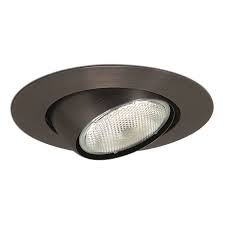 |
| Low-voltage recessed lighting fixtures used to illuminate art on a wall. |
Basically, recessed lighting consists of cylindrical “cans” recessed into the ceiling plane. A rough metal housing installs above the ceiling and contains the mounting hardware, lamp socket, and any necessary electrical hardware. A separate bezel or “trim” finishes the ceiling opening. The various trims are what distinguish one fixture type from another, since the housings concealed in the ceiling are all basically similar.
 |
| Slope-ceiling fixture with black Coilex baffle to reduce specular glare. |
The most common type of recessed fixture is an open-bottomed can containing a lamp (the technical term for light bulb) that’s “regressed” a few inches above the ceiling plane. The portion of the can interior that’s visible around the lamp can be either polished (specular) or fitted with a ribbed, black baffle (“Coilex”) to reduce eye-irritating reflections. A number of other specialized trims are available:
• Louvered trims having egg-crate grilles or concentric rings are used to achieve “cutoff” or shielding of the light source, and to direct light downward.
• Various types of lenses are available to cover the fixture opening, including translucent glass, plastic, and Fresnel. Gasketed, moisture-resistant lenses are available for bath or shower areas.
 |
| Gasketed fixture with Fresnel lens can be installed in the shower. |
• Wall washers use a special shielded trim to illuminate or “wash” wall surfaces, so that the wall itself becomes a dramatic indirect light source. They’re generally installed about 24” away from the wall, and spaced about twice that distance from each other.
• Trims having small-aperture slots or pinholes are available for concentrating light on specific objects or areas.
 |
| Classic eyeball spot, a mid-century favorite. |
• Eyeball spots (which require a special type of rough fixture) have a lamp installed in a spherical socket that allows aiming. Eyeballs are useful for spotlighting particular objects or areas, and for installation in sloped ceilings.
• Fixtures with angled bottom edges are also available for installation in sloped ceilings. They feature vertically-oriented cans with elliptical trims that eliminate awkwardly angled light beams or protruding eyeball trims.
Many of the above fixtures are also available in low-voltage versions that use high-intensity lamps. There are also special recessed fixtures designed for retrofitting into existing ceilings; they install through the hole cut for the trim.
 |
| Wall washers (at background) provide dramatic illumination of the textured stone, without annoying glare. |
With so many configurations available, you can really go wild with recessed lighting—sometimes too wild. Here are a couple of important caveats:
• Choose trims according to performance, not just looks. For example, plain recessed fixtures with specular reflectors look great but can create unpleasant glare or “hot spots”. If you want the light source to be less obtrusive, consider baffled trims or use Coilex-baffled fixtures instead.
• Lay the fixtures out carefully. Most people simply place recessed fixtures according to what they'll be lighting on the floor. Unfortunately, the resulting arrangements often look cluttered and haphazard when viewed in the context of the ceiling—the infamous "swiss cheese effect". While you should obviously consider the room’s lighting requirements, it’s also important to arrange the fixtures so that they produce some kind of rational pattern on the ceiling.

No comments:
Post a Comment